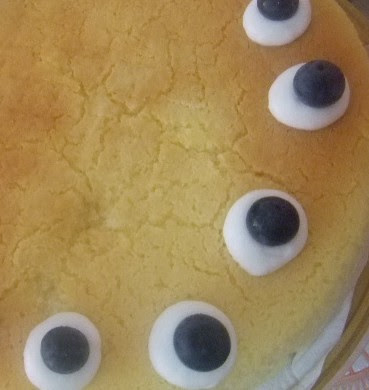
I learned this cheese cake at Genius r us , a culinary school for parent and child, and a place which Sheen and I absolutely enjoyed bonding over... and the best part? I need not worry about the vomitous cleaning up!
The cheesecake usually requires some skills, so I am surprised when this class was offered to masak-masak baker.
It is basically a mixture of cream cheese, milk, and butter, flour, egg yolk being folded into the stiff-whisked egg white to create the volume and leavening. If this step is done correctly, the cake will be light and airy... not quite the same as what you get in the japanese restaurant but good in it's own way.
In the class, the kids jostled to do the mixing, and in their frivolous enthusiastic, they ended up mixing (instead of folding), and losing a far bit of air in the process. The end game was a rather dense and heavy cheesecake. Moreover some blending ain't properly done, so I get some bit of the cream cheese mixture at the bottom of the cake.
So yesterday I baked another one; double the lemon juice and added zest from half a lemon. It makes the cake more tangy. I like it cos it lightens the taste of the heavy cheese.
It was brought to a family gathering and was whacked like tornado has just visited!

- Gwen-In can't wait for the rest to finish eating before the dessert was served.
- Sheen savouring the whipped cream. To him that's Creme de la Creme.
My bake notes :
- The dry heat in the oven will dry up the cake, and you won't achieve the cottony texture. An easy old way is to place the baking tray over a tray of water, somewhat like the water bath, to create a steamy environment that the cheesecake thrive on. This is known as bain marie in the books.
- Pass the cream cheese mixture through a sieve before folding in the egg white will ensure smooth batter.
- To ensure the cake does not sink when taken out of the oven, bake at low temperature. This gives a slow and steady rise, and ensure it stays there :-)
- After it was baked, I left the oven door ajar (half open) for 30min. I am not sure if this step applies to japanese cheesecake but I did anyway to avoid possible cracks on the cake. BTW, I noticed my cake still have small cracklines...
Unlike the european and new york cheesecake, this version is really soft, fluffy, melt in the mouth and not too sweet. But.... i won't be baking this often cos it uses helluva eggs... half of my "monthly allocation"!

No comments:
Post a Comment